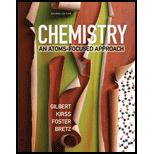
To find
The concentration of given elements in molality units.
Answer to Problem 11.64QA
Solution:
i. Molality of Al3+ is
ii. Molality of Fe3+ is
iii. Molality of Ca2+ is
iv. Molality of Na+ is
v. Molality of K+ is
vi. Molality of Mg2+ is
Explanation of Solution
1) Concept:
Here we assume
2) Formula:
A mole is the SI unit of amount chemical substance. When writing units, it is written as “mol”.
3) Given:
i. Concentration of Al3+ =
ii. Concentration of Fe3+ =
iii. Concentration of Ca2+ =
iv. Concentration of Na+ =
v. Concentration of K+ =
vi. Concentration of Mg2+ =
Conversion factor:
4) Calculations:
We will convert mass of river water from kilogram to gram.
Calculation of molality of Al3+.
We calculate the mass of Al3+ using
We will convert this mass from mg to kg using the conversion factor between them.
From mass of river water and mass of element we will calculate mass of solvent.
Convert mass of solvent from gram to kilogram using the conversion factor between them.
Now we calculate moles of solute using
Finally using mole solute and mass of solvent we can calculate molality of Al3+.
The molality of Al3+ is
Calculation of molality of Fe3+.
We calculate the mass of Fe3+ using 1 kg mass of river water and given concentration of Fe3+.
We will convert this mass from mg to kg using the conversion factor between them.
From mass of river water and mass of element we will calculate mass of solvent.
Convert mass of solvent from gram to kilogram using the conversion factor between them.
Now we calculate moles of solute using
Finally using mole solute and mass of solvent we can calculate molality of Fe3+.
The molality of Fe3+ is
Calculation of molality of Ca2+.
We calculate the mass of Ca2+ using 1 kg mass of river water and given concentration of Ca2+.
We will convert this mass from mg to kg using the conversion factor between them.
From mass of river water and mass of element we will calculate mass of solvent.
Convert mass of solvent from gram to kilogram using the conversion factor between them.
Now we calculate moles of solute using
Finally using mole solute and mass of solvent we can calculate molality of Ca2+.
The molality of Ca2+ is
Calculation of molality of Na+.
We calculate the mass of Na+ using 1 kg mass of river water and given concentration of Na+.
We will convert this mass from mg to kg using the conversion factor between them.
From mass of river water and mass of element we will calculate mass of solvent.
Convert mass of solvent from gram to kilogram using the conversion factor between them.
Now we calculate moles of solute using
Finally using mole solute and mass of solvent we can calculate molality of Na+.
The molality of Na+ is
Calculation of molality of K+.
We calculate the mass of K+ using 1 kg mass of river water and given concentration of K+.
We will convert this mass from mg to kg using the conversion factor between them.
From mass of river water and mass of element we will calculate mass of solvent.
Convert mass of solvent from gram to kilogram using the conversion factor between them.
Now we calculate moles of solute using
Finally using mole solute and mass of solvent we can calculate molality of K+.
The molality of K+ is
Calculation of molality of Mg2+.
We calculate the mass of Mg2+ using 1 kg mass of river water and given concentration of Mg2+.
We will convert this mass from mg to kg using the conversion factor between them.
From mass of river water and mass of element we will calculate mass of solvent.
Convert mass of solvent from gram to kilogram using the conversion factor between them.
Now we calculate moles of solute using
Finally using mole solute and mass of solvent we can calculate molality of Mg2+.
The molality of Mg2+ is
Conclusion
With the mass of river water and given concentrations of elements we find out the mass of each element. From the mass of element and mass of river water we find out mass of solvent. From the mass and molar mass of element we find out moles of each element. Finally using moles and mass of solvent in kg we find out molality of each element.
Want to see more full solutions like this?
Chapter 11 Solutions
CHEMISTRY:ATOMS-FOCUSED..-ACCESS
 ChemistryChemistryISBN:9781305957404Author:Steven S. Zumdahl, Susan A. Zumdahl, Donald J. DeCostePublisher:Cengage Learning
ChemistryChemistryISBN:9781305957404Author:Steven S. Zumdahl, Susan A. Zumdahl, Donald J. DeCostePublisher:Cengage Learning ChemistryChemistryISBN:9781259911156Author:Raymond Chang Dr., Jason Overby ProfessorPublisher:McGraw-Hill Education
ChemistryChemistryISBN:9781259911156Author:Raymond Chang Dr., Jason Overby ProfessorPublisher:McGraw-Hill Education Principles of Instrumental AnalysisChemistryISBN:9781305577213Author:Douglas A. Skoog, F. James Holler, Stanley R. CrouchPublisher:Cengage Learning
Principles of Instrumental AnalysisChemistryISBN:9781305577213Author:Douglas A. Skoog, F. James Holler, Stanley R. CrouchPublisher:Cengage Learning Organic ChemistryChemistryISBN:9780078021558Author:Janice Gorzynski Smith Dr.Publisher:McGraw-Hill Education
Organic ChemistryChemistryISBN:9780078021558Author:Janice Gorzynski Smith Dr.Publisher:McGraw-Hill Education Chemistry: Principles and ReactionsChemistryISBN:9781305079373Author:William L. Masterton, Cecile N. HurleyPublisher:Cengage Learning
Chemistry: Principles and ReactionsChemistryISBN:9781305079373Author:William L. Masterton, Cecile N. HurleyPublisher:Cengage Learning Elementary Principles of Chemical Processes, Bind...ChemistryISBN:9781118431221Author:Richard M. Felder, Ronald W. Rousseau, Lisa G. BullardPublisher:WILEY
Elementary Principles of Chemical Processes, Bind...ChemistryISBN:9781118431221Author:Richard M. Felder, Ronald W. Rousseau, Lisa G. BullardPublisher:WILEY





